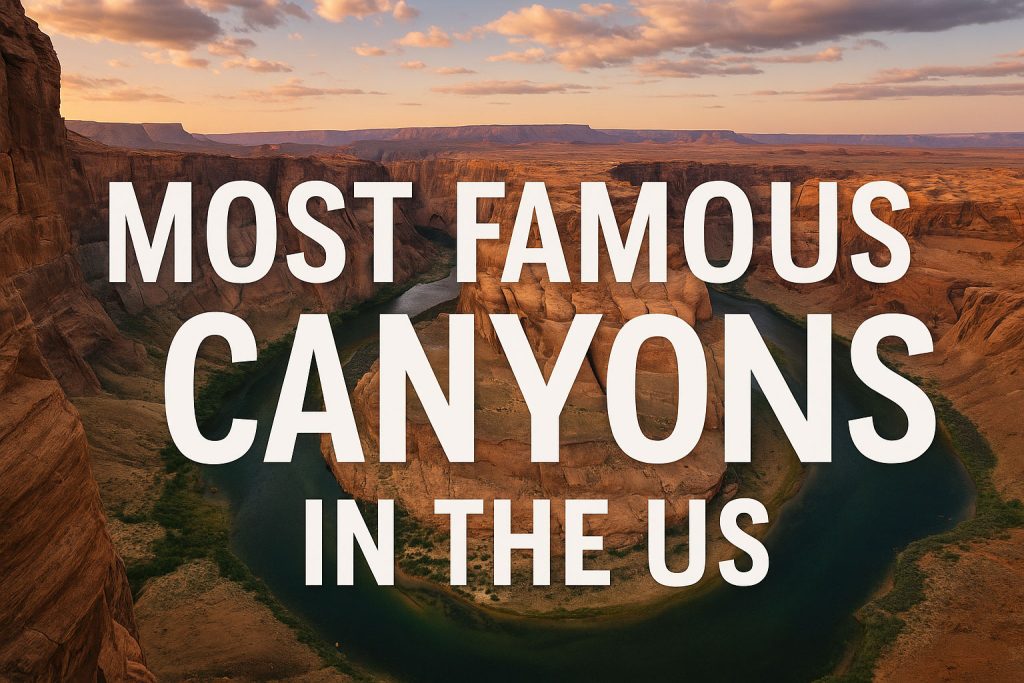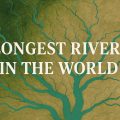From the colossal Grand Canyon to the hidden slot canyons of Utah, explore the most famous canyons in the US and plan your next breathtaking adventure.
The United States is a land carved by water, wind, and time—nowhere is that more evident than in its canyons. Towering cliffs, narrow slot passages, and vast desert chasms reveal layers of Earth’s history in spectacular color. From the world-renowned Grand Canyon to the surreal narrows of Antelope Canyon, each crack in the American landscape tells a story of erosion, endurance, and raw beauty. In this guide, we’ll explore the most famous canyons in the US, from iconic national parks to lesser-known treasures waiting to be discovered.
Journey through the rivers that shape the American landscape—explore our post to learn more.
Explore the fascinating geology, beauty, and scale of the world’s most majestic canyons.
Canyons of the United States – Where Earth Reveals Its Bones
Canyons are the scars of the Earth’s most beautiful wounds—deep, rugged gorges carved by rivers, ice, wind, and time. In the United States, these natural cathedrals appear where land meets force: where rivers gnaw through high plateaus, where glaciers have scraped valleys into stone, and where flash floods burst through soft sediment like chisels through clay.
How Canyons Form: The Art of Erosion
Most canyons in the U.S. are river-carved, formed over millions of years by flowing water slicing through uplifted terrain. Picture the Colorado River grinding its way through the Colorado Plateau, revealing rainbow-hued rock layers like pages in a geologic diary. Others, like parts of the Columbia River Gorge, owe their dramatic shapes to Ice Age megafloods that scoured the land with ferocious speed. Some are glacial in origin—wide U-shaped troughs now occupied by rivers or meadows.
The common denominator? A resistant top layer of rock, such as sandstone or basalt, that cracks and fractures under pressure, giving way to vertical cliffs, slot narrows, and dizzying drop-offs.
Where to Find Canyons in the US
Canyons are scattered across the nation, but some regions are particularly rich in them:
- The Colorado Plateau (Utah, Arizona, New Mexico, and Colorado) is the crown jewel. This region boasts the highest concentration of grand, photogenic canyons—thanks to its arid climate, uplifted mesas, and fast-moving rivers. The “Big Five” national parks of Utah (Zion, Bryce, Canyonlands, Capitol Reef, and Arches) are all carved masterpieces of canyon country.
- The Southwest Deserts, particularly Texas and Nevada, hold hidden canyons tucked among red-rock basins and desert plains.
- The Sierra Nevada and Rocky Mountains offer deep glacial and river-carved canyons with alpine drama and roaring falls.
- The Pacific Northwest delivers verdant, mist-filled gorges like the Columbia River Gorge, shaped by both river erosion and cataclysmic Ice Age floods.
- Hawaii and Alaska even host their own: volcanic or glacial canyons where tropical greenery or icy silence defines the experience.
In contrast, the eastern U.S. has fewer dramatic canyons due to its older, more eroded landscape—but you’ll still find Appalachian gorges and river valleys that hint at ancient tectonic upheavals.
Most Famous Canyons in the US: Nature’s Grandest Masterpieces
The canyons of the United States are colossal cathedrals carved by nature. From blazing red sandstone gorges to twisting slot corridors barely wider than your shoulders, these landscapes are sacred to geology, photography, and the thrill of awe. Here’s a journey through the most iconic and breathtaking canyons across the US—each with its own personality, palette, and power.
1. Grand Canyon – Arizona
The Icon of the American Southwest
There’s no canyon more famous—or more humbling—than the Grand Canyon. Stretching 277 miles long and over a mile deep, this UNESCO World Heritage Site is a monument to time itself. The Colorado River still roars at its base, carving deeper into billion-year-old rock layers.
Best viewpoints: Mather Point, Desert View, Toroweap
Activities: Hiking, rafting, helicopter tours, sunrise at the rim
Travel tip: Visit the North Rim in summer for solitude and dramatic alpine views
2. Antelope Canyon – Arizona
The Painted Slot of Light and Stone
A sacred Navajo site and a photographer’s dream, Antelope Canyon is a surreal corridor of smooth, flowing sandstone, sculpted by flash floods and lit by ethereal beams of light. The canyon is divided into Upper Antelope (The Crack) and Lower Antelope (The Corkscrew)—both equally mesmerizing.
Best time to visit: Midday (for light beams in Upper Antelope)
Permit required: Yes, guided tours only
Photographer’s tip: Bring a wide-angle lens to capture the canyon’s wave-like walls
3. Bryce Canyon – Utah
A Forest of Stone Spires
Technically not a canyon, but a vast natural amphitheater, Bryce is a fairytale world of hoodoos—thin, tall rock spires glowing orange, pink, and cream. The scene feels otherworldly, especially at sunrise when golden light dances between the formations.
Don’t miss: Sunrise Point, Navajo Loop, Queen’s Garden Trail
Altitude: Over 8,000 feet—dress in layers
Fun fact: Hoodoos are formed by frost-wedging and rain erosion
4. Zion Canyon – Utah
A Cathedral of Sandstone and Serenity
Zion National Park’s main canyon is a towering corridor of red cliffs and emerald trails. The Virgin River has carved a sanctuary of waterfalls, hanging gardens, and vertical hikes. Few trails in the US rival Angels Landing or The Narrows for sheer thrill and beauty.
Top hikes: Angels Landing (permit required), The Narrows (in-river hike), Emerald Pools
Tip: Visit in spring or fall for ideal weather
Wildlife: Look for bighorn sheep on the cliffs
5. Canyonlands – Utah
Utah’s Grandest Wilderness
Split into districts by the Colorado and Green Rivers, Canyonlands is vast, rugged, and remote. The Island in the Sky district offers panoramic views like Mesa Arch, while The Needles reveals colorful spires and labyrinthine canyons. The Maze is so wild, it’s one of the least accessible areas in the lower 48.
Highlights: Mesa Arch at sunrise, White Rim Road, confluence overlook
Access: 4WD recommended for deeper areas
Bonus: Stargazing here is world-class
6. Black Canyon of the Gunnison – Colorado
The Dark Heart of Colorado
Sheer, shadowy, and dramatic—Black Canyon slices so deeply into the Earth that sunlight barely reaches the river below. Its narrow, steep walls plunge more than 2,700 feet into the Gunnison River, earning it the nickname Colorado’s Grand Canyon with a darker edge.
Best overlooks: Painted Wall (highest cliff in Colorado), Chasm View
Activities: Scenic drives, intense rim-to-river hikes, kayaking (expert only)
Tip: The North Rim is more remote and less crowded
7. Columbia River Gorge – Oregon/Washington
A Lush Canyon of Waterfalls
Where desert meets rainforest, the Columbia River has carved a verdant gorge through the Cascades. It’s a world of mossy cliffs, cascading waterfalls, and scenic highways. The most famous waterfall here—Multnomah Falls—is one of the most photographed in America.
Top stops: Multnomah Falls, Vista House, Wahkeena and Horsetail Falls
Seasonal magic: Visit in spring when waterfalls thunder with snowmelt
Fun fact: The gorge was carved in part by Ice Age floods
8. Kings Canyon – California
Yosemite’s Wild Cousin
Often overshadowed by its glamorous neighbor, Kings Canyon is just as jaw-dropping—and far less crowded. Glacially carved granite cliffs, rushing alpine rivers, and vast meadows define this Sierra Nevada wonder. The canyon drops deeper than the Grand Canyon in some sections!
Access: Along the Kings Canyon Scenic Byway
Top spots: Zumwalt Meadow, Roaring River Falls, Mist Falls Trail
Best time: Late spring to early fall
9. Palo Duro Canyon – Texas
The Grand Canyon of Texas
Texas hides its own canyon country, and Palo Duro is the star. Second only to the Grand Canyon in size within the US, it stretches 120 miles through the Texas Panhandle. The red clay cliffs and unique formations like the Lighthouse Rock make this a vibrant desert escape.
Activities: Hiking, biking, horseback riding, camping
Insider tip: Don’t miss the sunset over the rim
Bonus: See the outdoor musical “TEXAS” in the summer at the amphitheater
10. Waimea Canyon – Hawaii (Kaua’i)
The Grand Canyon of the Pacific
Emerald peaks, rust-colored cliffs, and mist-shrouded valleys—Waimea Canyon is a painter’s palette made real. This Hawaiian wonder drops nearly 3,600 feet and offers dramatic views of tropical terrain rarely seen in mainland canyons.
Best viewpoint: Pu‘u Hinahina Lookout
Nearby hike: Awa‘awapuhi Trail (unforgettable ridgeline views)
Rainy season: Check weather before hiking—trails get muddy and slippery
Final Thoughts
From the scorched cliffs of Arizona to the rainforest valleys of Hawaii, the canyons of the US are more than mere gashes in the Earth—they are portals into deep time, culture, and adventure. Whether you’re peering into their depths from a lofty rim or wading knee-deep through their narrow arteries, these canyons will change the way you see the land—and yourself.
Which canyon will you explore first? Let the journey begin.


